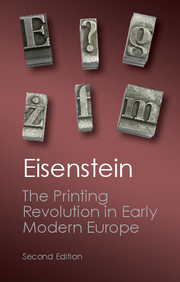Book contents
- Frontmatter
- Contents
- List of Illustrations and Maps
- Preface to the Second Edition
- Introduction
- THE PRINTING REVOLUTION IN EARLY MODERN EUROPE
- PART I THE EMERGENCE OF PRINT CULTURE IN THE WEST
- PART II INTERACTION WITH OTHER DEVELOPMENTS
- 5 The Permanent Renaissance: Mutation of a Classical Revival
- 6 Western Christendom Disrupted: Resetting the Stage for the Reformation
- 7 The Book of Nature Transformed: Printing and the Rise of Modern Science
- 8 Conclusion: Scripture and Nature Transformed
- Afterword: Revisiting the Printing Revolution
- Selected Reading
- Index
6 - Western Christendom Disrupted: Resetting the Stage for the Reformation
from PART II - INTERACTION WITH OTHER DEVELOPMENTS
Published online by Cambridge University Press: 05 October 2013
- Frontmatter
- Contents
- List of Illustrations and Maps
- Preface to the Second Edition
- Introduction
- THE PRINTING REVOLUTION IN EARLY MODERN EUROPE
- PART I THE EMERGENCE OF PRINT CULTURE IN THE WEST
- PART II INTERACTION WITH OTHER DEVELOPMENTS
- 5 The Permanent Renaissance: Mutation of a Classical Revival
- 6 Western Christendom Disrupted: Resetting the Stage for the Reformation
- 7 The Book of Nature Transformed: Printing and the Rise of Modern Science
- 8 Conclusion: Scripture and Nature Transformed
- Afterword: Revisiting the Printing Revolution
- Selected Reading
- Index
Summary
Between 1517 and 1520, Luther's thirty publications probably sold well over 300,000 copies … Altogether in relation to the spread of religious ideas it seems difficult to exaggerate the significance of the Press, without which a revolution of this magnitude could scarcely have been consummated. Unlike the Wycliffite and Waldensian heresies, Lutheranism was from the first the child of the printed book, and through this vehicle Luther was able to make exact, standardized and ineradicable impressions on the mind of Europe. For the first time in human history a great reading public judged the validity of revolutionary ideas through a mass-medium which used the vernacular language together with the arts of the journalist and the cartoonist.
As the opening citation from A. G. Dickens suggests, the impact of print, which is often overlooked in discussions of the Renaissance, is less likely to go unnoted in Reformation studies. In this latter field, historians confront a movement that was shaped at the very outset (and in large part ushered in) by the new powers of the press. “The Reformation was the first religious movement,” it has been said, “which had the aid of the printing press.” Even before Luther, however, Western Christendom had already called on printers to help with the crusade against the Turks. Church officials had already hailed the new technology as a gift from God – as a providential invention which proved Western superiority over ignorant infidel forces.
- Type
- Chapter
- Information
- The Printing Revolution in Early Modern Europe , pp. 164 - 208Publisher: Cambridge University PressPrint publication year: 2012



